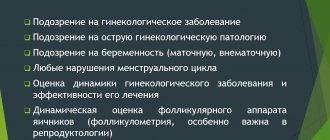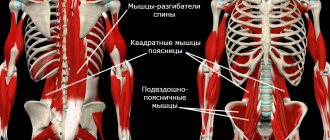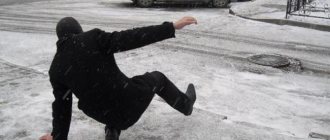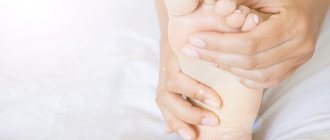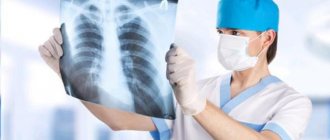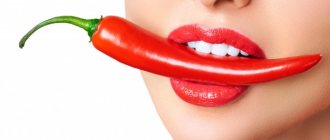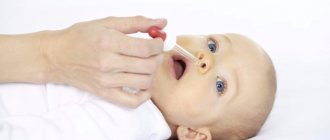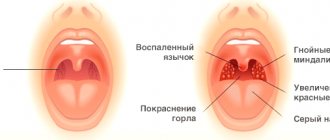Back pain
- a common complaint. Usually we talk about back pain when pain is felt in the lumbar region. Sometimes in such cases they say that “the back is pinched.” According to recent studies, out of every five people, four have experienced such pain at least once in their lives. Read more about lower back pain>>>
Another typical location of back pain is under the right or left shoulder blade or between the shoulder blades. Read more about pain under the shoulder blade>>>
With age, back pain is more common - among older people, every second person experiences such pain from time to time.
Back pain can have a different character: it can be sharp, stabbing, burning, aching, pulling, and can radiate to other parts of the body (for example, to the chest, legs, abdomen, genitals). The pain may be occasional or constant.
When listening to pain, a person usually asks himself two questions: should he see a doctor, and which doctor should he go to for back pain? Let's try to answer these questions.
Why does my back hurt?
This may be associated with diseases of the internal organs, spinal trauma (including fracture), neurological pain usually indicates osteochondrosis, and sometimes it is a symptom of gastrointestinal pathology, kidney stones, etc.
In addition, the back is somewhat prone to injury and pain. The spine performs at least 4 functions: supporting, protective, shock-absorbing and motor. Therefore, if pain appears, it may be a consequence of poor posture, strong one-time load, sudden movement or turn.
What to do if you have back pain?
See a doctor and get examined. Based on the diagnosis, it will become clear how to cure back pain, depending on its root cause.
Reason 2. Degenerative-dystrophic diseases
Caused by wear and tear of the intervertebral discs, brittle bones, and loss of elasticity of spinal tissue. Moreover, such changes are not necessarily age-related. Today, young people also suffer from arthritis, spondylosis, and osteochondrosis.
Over time, pathological processes in the spine become degenerative, i.e. irreversible. In this case, it is necessary to use surgical treatment methods - joint replacement, surgical restoration of vertebrae and other structures. Arthrosis, osteoporosis, and radiculitis often develop into a degenerative form.
Of course, such changes do not occur without symptoms. Often patients note lumbago, acute pain in the affected area, limited mobility, stabbing pain, crunching, pain with certain movements (for example, in the lower back when bending forward). As a rule, a person can clearly determine exactly where it hurts.
Treatment of degenerative-dystrophic diseases is carried out by a rheumatologist, osteopath, chiropractor, traumatologist, neurologist and a number of other specialists. Don't know who to contact? Make an appointment with a general practitioner first.
Causes of back pain
Finding out why your back hurts is not easy. The fact is that the spine is at the same time a support, protection, and shock absorption of the body. If chronic back pain appears, the problem is a violation of any of these functions.
If you feel back pain between the shoulder blades, it may be associated with bronchitis and cough. If your back muscles hurt, the discomfort may be due to overexertion due to heavy lifting the day before. Back pain on the right or left can be caused by a sudden rotation of the body.
There are more serious causes of periodic sharp pain. For example, inflammation of internal organs, kidney stones, spinal bruise. If diagnostics of the back do not show degenerative changes, it is worth examining the internal organs. Thus, discomfort in the lumbar region may be a symptom of nephrosis.
In one case or another, the treatment is different, so first of all you need to establish the cause.
Types of diseases based on the nature of back pain
Possible causes of aching pain :
- myositis;
- lumbago;
- intervertebral hernia.
It worsens when lifting weights, physical work, hypothermia, or staying in one position for a long time.
Causes of shooting pain in the limbs :
- intervertebral hernia;
- radiculitis;
- osteochondrosis.
Discomfort increases with walking, bending, coughing and sneezing. Feeling weak in the legs and arms.
Causes of throbbing pain :
- intervertebral hernia;
- osteochondrosis;
- lumbago;
- spondylosis.
The discomfort does not go away even after taking an analgesic.
Possible causes of bursting and pressing pain :
- in the chest area - pulmonary embolism and myocardial infarction;
- on any part of the spine - spondyloarthrosis;
- in the lumbar region - intestinal obstruction;
- in the neck area - atherosclerosis.
| Nature of pain | Diseases that cause it |
| Aching back pain (acute and chronic) | Lumbago (shooting in the lower back). The reason is hard physical labor. It usually goes away on its own within a few days. |
| Myositis, muscle strain, sudden heavy lifting, hypothermia, maintaining an uncomfortable position for a long time, for example during work. | |
| Displacement of intervertebral discs. The most common cause is osteochondrosis, but displacement can also occur with sudden heavy lifting and constant high physical activity. | |
| Sharp, radiating to the extremities | Osteochondrosis. Causes nagging pain in the back that radiates to the leg and becomes stronger when sneezing, coughing, or straining. |
| Radiculitis. Constant sharp (stabbing) or dull pain. It is usually localized on one side, can radiate to the thigh, buttock, leg, lower leg, and sometimes causes numbness and itching. The pain can also be burning and intensifies with movement. | |
| Intervertebral hernia. With this pathology, pain occurs when bending over, lifting heavy objects, intensifies when sneezing, coughing, moving, and is accompanied by weakness in the leg. | |
| Throbbing pain, severe, may not go away after taking an analgesic | Osteochondrosis, cracks in the vertebrae, lumbago, intervertebral hernia, spondylosis. |
| Bursting | In the upper back and in the middle of the sternum - may indicate angina pectoris, myocardial infarction, pulmonary embolism. In the lower back - intestinal obstruction, spondyloarthrosis. |
| Pressing | Angina pectoris, myocardial infarction, problems with the gallbladder (pain occurs after eating), atherosclerosis, hypertensive crisis. |
Why does my back hurt after sleep?
After waking up in the morning, you feel stiffness, discomfort and pain below the shoulder blades, in the right or left side, in the lumbar region. These sensations can be associated not only with an incorrect sleeping position or resting on an incorrectly selected mattress. After sleep, your back hurts for the following reasons:
- during the day physical work was performed with sudden lifting of weights;
- back muscles are weakened;
- intervertebral hernia or osteochondrosis is diagnosed;
- hypothermia occurred;
- the spine is curved, causing the muscles to contract unevenly;
- obesity, due to which the load on the spine is distributed unevenly;
- pregnancy;
- stress.
Diseases associated with joints and the spinal column
Back pain in the spinal area can occur due to the development of pathologies of the musculoskeletal system such as:
- Ankylosing spondylitis. The paravertebral muscles spasm, so to relieve discomfort the patient tilts the body forward. Over time, the vertebrae become woody, inflamed and fused, so the flexibility and mobility of the spine is impaired.
- Spondylolisthesis and spondylolysis. Due to these diseases, pain is mainly localized in the lumbar region. The vertebrae move forward or backward and compress the nerve endings;
- Osteochondrosis. The depreciation of the spine worsens. The discs between the vertebrae crack, the fibrous ring ruptures, and through the resulting cracks the core of the disc comes out and is pinched.
- Rheumatoid arthritis. Develops in the knees, shoulders, hip joint and moves to the cervical spine. In the morning, you feel stiffness and lumbago due to excess pressure on the nerves from the affected vertebrae.
- Osteomyelitis. Infection of the bone tissue of the spine causes inflammation and severe muscle pain.
- Reiter's disease results from inflammation of the small supporting muscles of the back.
- Intervertebral hernia due to the fact that during movement the protrusion between the vertebrae is compressed and pinched.
Muscle-related diseases
When determining the causes of back pain, tightness and spasms of the muscular corset that supports the spine are often discovered. Mobility is impaired as a result of:
- Fibromyalgia. My back hurts from my neck to my lower back. Neurological symptoms can be observed - sensitivity increases when pressing certain points on the back.
- Polymyositis. The back muscles become inflamed due to hypothermia and overexertion. It hurts to turn the body, muscle weakness is felt.
- Dermatomyositis. The skin near the striated and smooth muscles of the back becomes inflamed.
- Charcot's disease. The peripheral nerves that run along the spine become inflamed. Sensitivity worsens, muscle weakness increases, and gait changes.
- Polymyalgia rheumatica. It is difficult to raise your arms and stand on your feet without the help of someone else. The asymmetry of the back is noticeable.
Spinal cord pathologies
Back pain often occurs due to spinal cord compression. The spinal cord is the connecting link between the brain and the body. It runs from the head to the tailbone in the spinal canal between the vertebrae. There are 31 branches leaving the spinal cord. Each nerve is responsible for the innervation of one or another part of the body. The back may hurt due to pinching or inflammation of any part of the spinal cord as a result of:
- compression of the spinal membranes due to a spinal fracture, abscess or hematoma;
- cerebrovascular accidents;
- inflammation of nearby muscles;
- lack of vitamins and minerals;
- hemorrhages;
- complications of syphilis or HIV;
- multiple sclerosis;
- back tumors of various etiologies.
Back pain due to psychosomatics
Increasingly, back discomfort is not associated with physical illness. After the examination, no pathology is detected, which means that pain in the back and joints is caused by psychological factors. Unpleasant sensations can be triggered by depression, chronic stress, nervous tension, and sexual dissatisfaction. Due to nervousness, the gait changes, lumbago worsens, and sensory disturbances appear.
Reason 7. Spinal tumors
These are cystic formations and cancerous tumors.
A cyst is a bubble with blood. It appears as a result of various types of hemorrhages in the spine. The cyst is characterized by constant severe pain, which can only be relieved with the help of painkillers. Numbness and tingling in the extremities can also be symptoms of a cyst.
Cancer can be primary or secondary. Primary is cancer that has formed in the spinal column, secondary is metastases, that is, secondary tumors that form in late stages in all organs. With malignant tumors, pain may be accompanied by muscle weakness and loss of sensitivity in certain areas.
Neoplasms in the spine are studied by a vertebrologist, oncologist, and neurosurgeon.
Causes of back pain by location
At different points of the back and spine, discomfort can be caused by different factors. Let's take a closer look at them.
Pain on the right side
Most often, the right side from the back hurts due to lordosis, kyphosis or scoliosis, as well as displacement of the intervertebral disc. The development of the following pathologies can be assumed:
- appendicitis;
- kidney stone disease;
- cholecystitis;
- salpingitis;
- oophoritis;
- nephritis;
- obesity;
- myositis.
Pain on the left side
If the unpleasant sensations are localized under the rib or near the lower back on the left side of the back, the following may develop:
- splenitis;
- urolithiasis;
- pinched spine;
- duodenitis.
Pain on the left in the hypochondrium indicates bronchitis, pleurisy, intercostal neuralgia, and heart pathologies. If the left side of the back hurts from below, doctors suspect a disease of the pelvic organs.
Pain in the lumbar region
The lumbar spine is the most mobile area and is subject to heavy loads. Because of this, the five lumbar vertebrae most often become inflamed from radiculitis, intervertebral hernia and osteochondrosis. Slightly less frequently diagnosed:
- infections – spinal tuberculosis or brucellosis;
- Reiter's disease;
- rheumatoid arthritis;
- osteoporosis;
- sciatica;
- sciatica.
In the lumbar area on the right
Burning and cutting pain just above the lower back appears with curvature of the spine, spinal tuberculosis, neuralgia, osteomyelitis. The pain extends not only to bone tissue, but also to the muscle corset.
Nagging pain signals the development of scoliosis, myositis, and degenerative changes in the vertebrae. If therapy does not bring results within several months, the patient is examined for a malignant tumor.
Acute and sharp pain indicates the need to diagnose stones in the urinary or gall bladder, inflammation of the kidneys or neoplasms in them.
Left lumbar region
Most often, the left side hurts from below after running or sports training. This usually goes away within a few hours. But if the aching pain only increases, you need to exclude the possibility of circulatory disorders, scoliosis and osteochondrosis. Most often, these diagnoses occur in people who work while sitting.
Constant pain on the left side while walking is typical for patients with diabetes mellitus and radiculitis. A distinctive feature is that it passes at rest.
The most dangerous pain is on the left side between the left shoulder blade and lower back during myocardial infarction. Unpleasant sensations radiate along the left half of the body, so you need to quickly provide medical assistance.
Shoots in the left side of the lower back with a stomach ulcer, but the difference is in the nature of the pain. The pain in this case is acute, “dagger-like”.
Pinched nerve
Sciatica is compression of the sciatic nerve without destruction of the myelin sheath. Most often, sciatica is a consequence of osteochondrosis. The pain in this case is characterized by sharp and sharp jabs that radiate to the lower limb, sacrum, and lower back.
The nerve can become pinched in late pregnancy due to a change in the center of gravity. Less commonly, the pathology is caused by spasm of the piriformis muscle, spinal canal stenosis, or infection of bone tissue.
Intervertebral hernia
A herniation is a protrusion of the disc core after the destruction of the fibrous ring and a decrease in the elasticity of the disc. The deformity is associated with increased load on the spine, lack of nutrients and impaired metabolism. With the slightest load and heavy lifting, the distance between the vertebrae decreases, so the hernia protrudes more. The pain is sharp and sharp. It radiates to the buttock, arm or leg, and is also accompanied by a decrease in sensitivity of the limbs.
In the area of the shoulder blades
The paired bones in the clavicle and humerus area connect the back muscles and the shoulder corset. The pain is localized under the shoulder blades, between them, on the left or right side, between the ribs. Depending on the cause, back pain in the area of the shoulder blades can occur spontaneously, after an equal period of time, in paroxysms.
The characteristics of the pain indicate a possible diagnosis:
- If the pain is dull or aching, increases gradually, is relieved with medication, a stomach ulcer may develop. In this case, the pain is accompanied by dyspepsia, heartburn, bitterness in the mouth, and nausea.
- If the pain is aching and radiates to the shoulder, intensifies when moving the arm, scapular-costal syndrome develops. Accompanied by a crunching joint.
- If the pain is unbearable and intensifies during inhalation, body movement, coughing or sneezing, then this is intercostal neuralgia.
- If there is pain between the shoulder blades, but at the same time you feel dizzy, your blood pressure changes, and your arms go numb, then this is osteochondrosis.
- If there is pain under the shoulder blade on the left, while discomfort is felt in the chest and under the collarbone, then angina pectoris has worsened.
Pain along the spine and in the back
Pain throughout the spine or at a specific point indicates that the nerve endings are pinched. Exacerbation occurs with curvature.
If the pain is not severe, we can assume protrusion. As discomfort increases, protrusion can develop into osteochondrosis.
Vertebral pain occurs with myalgia, osteoarthritis, vertebral fracture, spondylosis. With ankylosing spondylitis, the pain is constant and sharp.
Causes of pain below the lower back
Basically, the lumbosacral region is susceptible to osteochondrosis and spondyloarthrosis, but less often the lower back and tailbone hurt due to displacement of intervertebral discs, scoliosis, pregnancy, endometritis, vulvitis, cervicitis, Crohn's disease, ulcerative colitis.
Reason 3. Intervertebral hernia
Intervertebral hernia is the “squeezing out” of the nucleus pulposus by neighboring vertebrae. The nucleus pulposus is a kind of hinge that is located in the center between the vertebrae and ensures their mobility. Therefore we can bend in all directions. But this structure is semi-liquid, and with increased or sudden physical activity it can “crawl” beyond the intervertebral space, forming a hernia.
The pain is acute, pronounced, and sharply intensifies with exercise. May be accompanied by impaired sensitivity in the arms and legs, numbness and pain in the extremities, and radiate to the buttock.
An intervertebral hernia can be diagnosed by an orthopedist, neurologist, neurosurgeon, or vertebrologist.
Symptoms that accompany back pain
The clinical picture of spinal pain depends on the location:
| Cervical spine | Thoracic spine | Lumbar spine |
| Headaches and dizziness | Burning in the chest | Change in the number of urinations |
| Numbness and weakness of the hands down to the fingertips | Difficulty in inhaling/exhaling | Numbness and weakness of the lower extremities, including the buttocks and toes |
| Blood pressure surges | Feeling of tightness in the chest | Low sensitivity during bowel movements |
| Floaters and flashes in the eyes | Pain between and under the shoulder blades | Erectile dysfunction and decreased libido |
Situations in which you need to see a doctor as soon as possible
Usually the pain subsides within a few days. If the discomfort only increases, the pain is intense, then medical attention is needed.
You should call a medical team or go to the clinic yourself in the following cases:
- there has been a recent spinal injury or back injury;
- it is not possible to find a comfortable body position in which it becomes better;
- at night the condition worsens;
- the patient is under 20 years old or over 55 years old;
- the patient has a fever;
- neurological symptoms increase - limbs go numb, tingle, weaken;
- gait has changed;
- lumbago is felt in the shin;
- corticosteroids and non-steroidal anti-inflammatory drugs do not relieve pain;
- limbs become numb, tingle, and weak.
Diagnostics
To make a diagnosis of back pain, you need to make an appointment with a neurologist, take tests if necessary, and also undergo hardware testing as prescribed by a specialist.
- Blood tests.
They allow you to determine the presence of infection, ESR (increased erythrocyte sedimentation rate, which indicates inflammation, infection). If an increased level of leukocytes is detected, then this is also a sign of inflammation and infection. Also, blood tests can determine iron deficiency anemia, the cause of which may be oncology. - Hardware diagnostics.
- Duplex and triplex ultrasound scanning of the vessels of the neck and brain. Allows you to anticipate the structure and patency of blood vessels, the presence of narrowing or dilatation, plaques, blood clots, as well as compliance of blood flow with standards. It is used in diagnosing the causes of headaches, dizziness, high blood pressure, as well as in cases of suspected cerebrovascular accident, and in the early diagnosis of pre-stroke conditions.
- MRI (magnetic resonance imaging). The most accurate and effective examination method. Allows you to visualize tumors on the vertebrae, herniated intervertebral discs, compression (and its degree) of the spinal nerves and spinal cord, narrowing of the spinal canal, inflammatory changes, including post-traumatic ones. MRI is required before surgery and in the postoperative period.
- CT (computed tomography). Detects vertebral fractures and their nature, allows you to find even very small fragments if they were formed due to injury. Based on the data obtained, you can create a 3D image of the desired area. CT “sees” what went unnoticed during radiography.
- Radiography. Allows you to assess the condition of bone structures. It is carried out to diagnose fractures, arthritis, spondylolisthesis, and the degree of postural impairment. It can be performed with functional tests, that is, when the patient flexes and extends the spine during the examination. Visualizes inflammation of the joints in the spine, helps to identify the localization of compression of the nerve processes by indirect signs. The degree of color intensity of the vertebrae in the image allows you to evaluate their strength (with osteoporosis they are more “transparent”, and when healthy they are bright white).
- Electromyography (EMG). A study aimed at determining the condition of nervous tissue. It evaluates the electrical impulses produced by the nerves, as well as the reaction of the muscles to them. Electromyography helps identify nerve compression caused by stenosis (narrowing) of the spinal canal or intervertebral hernia.
- Bone scan. This test is necessary if the doctor suspects a bone tumor or compression fracture due to osteoporosis.
Treatment for back pain
Most often, patients do not know which doctor to see. A neurologist provides comprehensive treatment for back pain. It is he who should be contacted for problems with the spine. However, before a specialist arrives or visits him, you need to provide first aid for back pain.
How to relieve or relieve pain at home?
The most important thing is to relax. To do this, you need to lie on your stomach on a hard and flat surface. Best of all - on the floor. After a few minutes, you need to carefully roll over onto your back and raise your legs, fixing them so that your hips are at an angle of 90 degrees. This will take the load off your spine.
You can use anti-inflammatory drugs in the form of ointments and creams. After relieving the pain, you need to carefully get up and fix the painful area, for example, by bandaging it with a scarf or towel.
How to relieve pain if there are no painkillers?
Severe pain can be relieved with something as simple as a cold compress. It will not give complete relief, but it will alleviate the condition. This could be a product from the freezer, an ice pack, etc. You can also help with pain by applying a heating compress or heating pad. It’s just important not to overheat the sore spot.
What else helps?
Light physical activity aimed at warming up the muscles and increasing blood circulation will help relieve discomfort. This could be a leisurely walk, muscle stretching exercises.
Medicine against pain: methods of medical intervention
First of all, the disease that caused the pain is determined and its treatment begins. Along the way, medications are used to relieve discomfort and treat chronic pain:
- analgesics, NSAIDs, in rare cases – narcotic painkillers;
- B vitamins;
- muscle relaxants.
The person is prescribed bed rest and wearing a fixing corset (for example, for neuralgia).
An important stage of treatment is physiotherapy . Its main methods:
- electrophoresis with drugs;
- phonophoresis;
- laser therapy;
- magnetic therapy.
Reflexology is also provided :
- electrical neurostimulation;
- acupuncture techniques.
Massage, osteopathy, manual therapy, exercise therapy are effective for back pain. These techniques are used when pain is caused by diseases of the muscles and spine, during rehabilitation after injuries.
Low risk
No risk factors
NSAIDs differ in the severity of their ulcerogenic effects.
Indomethacin has the highest risk of gastrointestinal complications (relative risk {RR} 2.25), followed by naproxen (RR 1.83), diclofenac (RR 1.73), piroxicam (RR 1.66), ibuprofen (RR 1.43), and meloxicam (OR 1.24).
A dose-dependent effect of the drugs was noted (Richy F, Bruyere O, Ethgen O, 2004):
Low-dose ibuprofen (RR 1.6, 95% confidence interval 0.8-3.2)
High-dose ibuprofen (RR 4.2, 95% confidence interval 1.8–9.8)
Low-dose naproxen (RR 3.7, 95% confidence interval 1.7-7.7)
Naproxen at high doses (RR 6.0, 95% confidence interval 3.0-12.2)
Low-dose indomethacin (RR 3.0, 95% confidence interval 2.2-4.2)
High-dose indomethacin (RR 7.0, 95% confidence interval 4.4-11.2)
Not included in this review, ketorolac also has a pronounced gastrotoxic effect. In one study (García Rodríguez LA, Cattaruzzi C, 1998), it was shown that the risk of developing adverse events from the gastrointestinal tract with the drug is 5.5 times higher than that of other NSAIDs. Therefore, the duration of taking the drug is limited to 5 days.
In Russia and abroad, the drug is available with a prescription.
Despite the possibility of early gastrotoxicity, in most cases it does not appear within several weeks of taking the drugs. The possibility of modifying risk factors depends on the conditions of medical care for the patient.
- Patients with a history of complicated or uncomplicated gastrointestinal ulcer disease are advised to undergo testing for H. pylori before prescribing NSAIDs or aspirin. If the result is positive, appropriate treatment is carried out (even in cases where it is assumed that the previous development of ulcers was associated with taking NSAIDs).
- It is necessary to use minimal doses of drugs, the course of treatment should be as short as possible.
- In patients with an average and high risk of complications from the gastrointestinal tract, the use of selective COX-2 inhibitors or NSAIDs in combination with antisecretory drugs: proton pump inhibitors (omeprazole 20 mg/day, esomeprazole 20 mg/day up to 6 weeks), H2 blockers is indicated -histamine receptors (ranitidine 150 mg/day once at night, famotidine 40 mg x 2 times a day). Both groups of drugs reduce the severity of dyspepsia in patients. Efficacy at recommended doses is similar.
- In patients with a high risk of complications from the gastrointestinal tract, selective COX-2 inhibitors may be prescribed in combination with antisecretory drugs
- Concomitant use of aspirin with COX-2 inhibitors completely eliminates the gastrointestinal safety benefits of the latter.
- Unexplained anemia, iron deficiency, severe dyspepsia, signs of gastrointestinal bleeding indicate a possible complication of taking NSAIDs. It is necessary to consider the possibility of performing esophagogastroduodenoscopy.
Prevention
Clinical recommendations for the prevention of intervertebral hernias and osteochondrosis :
- move more, do gymnastics in the morning, do yoga;
- take a contrast shower followed by rubbing with a towel to enhance metabolic processes;
- undergo a massage course every six months (up to 10 sessions);
- maintain liver health, because collagen production depends on it;
- increase immunity;
- avoid stress, establish a smooth psychological background;
- control your weight, because every extra 10 kg is approximately 0.5 kg of additional load on one vertebra, which leads to rapid wear.
In addition, it is important:
- Stand and walk correctly. Correct posture is when you stand against the wall and touch it with the back of your head, shoulder blades, buttocks and heels. When walking and standing, you should try to maintain exactly this position.
- Sit in the correct position: do not lean too far back, do not lean forward. You should press your back tightly against the back of the chair, have support for your lower back and neck. Every 15 minutes – change the position of your legs, stretch.
- Sleep on an anatomically correct or orthopedic mattress.
- After waking up, while still in bed, do simple exercises with your legs and arms, stretch before getting up (this should be done without sudden movements).
- Do not carry heavy bags in one hand. It is better to distribute purchases evenly into two packages.
- Do not carry a bag over your shoulder. Better for your back is a backpack with two straps.
- A small child should be carried with a straight back, without bending backwards. It is best to carry a very small baby on the chest in a special sling, and a slightly older one - on the back.
- When carrying heavy objects, do not bend or turn your body.
- Do not bend over when cleaning - use an extension cord for the vacuum cleaner handle and a mop (do not wash the floors with just a rag while kneeling).
- Eat grapes, apples, strawberries, pears, lentils, hazelnuts, pumpkin, green salad, and raspberries more often.
- Monitor the balance of magnesium and potassium in your diet. Eat nuts, fish, seafood, spinach, cabbage, beans, peas.
- Eliminate bad habits - alcohol and smoking.
- Swimming, running (but only with shock-absorbing insoles and special sports shoes), skiing.
Be sure to visit doctors for preventive examinations to prevent the situation from worsening if you have an illness and to begin treatment on time.
Centrally acting muscle relaxants
According to systematic reviews, combined treatment with NSAIDs and centrally acting muscle relaxants is more effective than NSAID monotherapy. The use of muscle relaxants is accompanied by an increase in the frequency of adverse events, primarily general lethargy and drowsiness. The most studied drug is tizanidine. The drug is used in doses of 2-4 mg x 2 times a day. The most common adverse events are sedation and hypotension.
Benzodiazepine tranquilizers have a similar effect. Drugs in this group can be used in a hospital setting to enhance the effect of NSAIDs.
